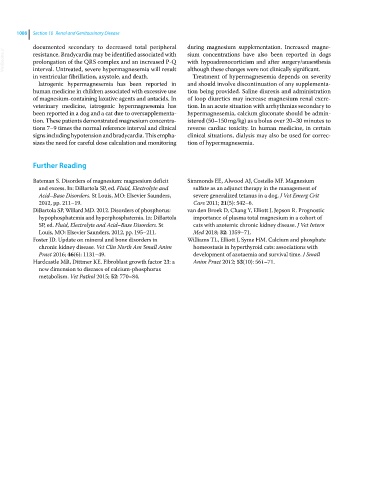Page 1150 - Clinical Small Animal Internal Medicine
P. 1150
1088 Section 10 Renal and Genitourinary Disease
documented secondary to decreased total peripheral during magnesium supplementation. Increased magne
VetBooks.ir resistance. Bradycardia may be identified associated with sium concentrations have also been reported in dogs
with hypoadrenocorticism and after surgery/anaesthesia
prolongation of the QRS complex and an increased P‐Q
interval. Untreated, severe hypermagnesemia will result
Treatment of hypermagnesemia depends on severity
in ventricular fibrillation, asystole, and death. although these changes were not clinically significant.
Iatrogenic hypermagnesemia has been reported in and should involve discontinuation of any supplementa
human medicine in children associated with excessive use tion being provided. Saline diuresis and administration
of magnesium‐containing laxative agents and antacids. In of loop diuretics may increase magnesium renal excre
veterinary medicine, iatrogenic hypermagnesemia has tion. In an acute situation with arrhythmias secondary to
been reported in a dog and a cat due to oversupplementa hypermagnesemia, calcium gluconate should be admin
tion. These patients demonstrated magnesium concentra istered (50–150 mg/kg) as a bolus over 20–30 minutes to
tions 7–9 times the normal reference interval and clinical reverse cardiac toxicity. In human medicine, in certain
signs including hypotension and bradycardia. This empha clinical situations, dialysis may also be used for correc
sizes the need for careful dose calculation and monitoring tion of hypermagnesemia.
Further Reading
Bateman S. Disorders of magnesium: magnesium deficit Simmonds EE, Alwood AJ, Costello MF. Magnesium
and excess. In: DiBartola SP, ed. Fluid, Electrolyte and sulfate as an adjunct therapy in the management of
Acid–Base Disorders. St Louis, MO: Elsevier Saunders, severe generalized tetanus in a dog. J Vet Emerg Crit
2012, pp. 211–19. Care 2011; 21(5): 542–6.
DiBartola SP, Willard MD. 2012. Disorders of phosphorus: van den Broek D, Chang Y, Elliott J, Jepson R. Prognostic
hypophosphatemia and hyperphosphatemia. In: DiBartola importance of plasma total magnesium in a cohort of
SP, ed. Fluid, Electrolyte and Acid–Base Disorders. St cats with azotemic chronic kidney disease. J Vet Intern
Louis, MO: Elsevier Saunders, 2012, pp. 195–211. Med 2018; 32: 1359–71.
Foster JD. Update on mineral and bone disorders in Williams TL, Elliott J, Syme HM. Calcium and phosphate
chronic kidney disease. Vet Clin North Am Small Anim homeostasis in hyperthyroid cats: associations with
Pract 2016; 46(6): 1131–49. development of azotaemia and survival time. J Small
Hardcastle MR, Dittmer KE. Fibroblast growth factor 23: a Anim Pract 2012; 53(10): 561–71.
new dimension to diseases of calcium‐phosphorus
metabolism. Vet Pathol 2015; 52: 770–84.

